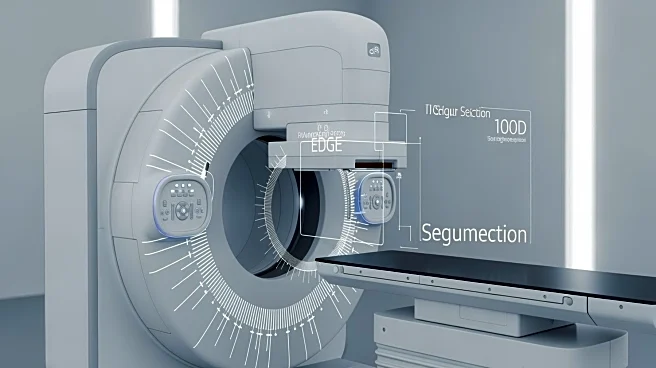What's Happening?
Researchers have introduced a novel Edge Guided Bidirectional Iterative Network (EGBINet) aimed at improving medical image segmentation. The network utilizes a multi-stage process to enhance the extraction
and decoding of regional and edge features from medical images. In the first stage, encoded features are extracted using models like VGG19, providing semantic information for iterative optimization. The process involves progressive decoding strategies inspired by UNet, enabling cross-layer fusion of features. The second stage incorporates edge features and decoded regional features back into the encoder, emphasizing target-related information. A transformer-based multi-level adaptive collaboration module (TACM) is employed to customize weights for spatial positions and feature subgroups, ensuring high-quality feature fusion. This approach addresses issues like confusion between lesion boundaries and normal tissues by assigning higher weights to more useful subgroups.
Why It's Important?
The development of EGBINet represents a significant advancement in medical imaging technology, potentially improving diagnostic accuracy and treatment planning. Enhanced image segmentation can lead to better identification of lesions and abnormalities, crucial for early detection and intervention in various medical conditions. The use of adaptive collaboration modules ensures that the most relevant features are emphasized, reducing errors in image interpretation. This technology could benefit healthcare providers by streamlining the analysis of complex medical images, ultimately improving patient outcomes. Additionally, the integration of advanced neural network techniques like transformers highlights the growing role of artificial intelligence in healthcare, paving the way for more sophisticated and automated diagnostic tools.
What's Next?
Future developments may focus on refining the EGBINet model to further enhance its accuracy and efficiency. Researchers might explore its application across different types of medical imaging, such as MRI and CT scans, to broaden its utility. Collaboration with healthcare institutions could facilitate real-world testing and validation, ensuring the model's effectiveness in clinical settings. As the technology evolves, it may lead to the development of new diagnostic software that integrates seamlessly with existing medical imaging systems. Stakeholders, including medical professionals and technology developers, are likely to monitor these advancements closely, considering potential impacts on healthcare delivery and patient care.
Beyond the Headlines
The introduction of EGBINet raises important ethical considerations regarding the use of AI in healthcare. Ensuring the transparency and accountability of AI-driven diagnostic tools is crucial to maintaining trust among patients and healthcare providers. Additionally, the technology's reliance on large datasets for training may necessitate discussions around data privacy and security. Long-term, the integration of AI in medical imaging could shift the role of radiologists and other specialists, requiring new skills and training to work alongside advanced technologies. The potential for AI to reduce human error in diagnostics also highlights the need for ongoing evaluation of its impact on healthcare practices.











